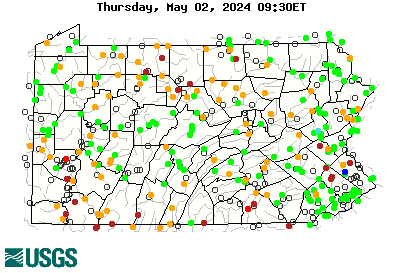Rusties were first found in two Lancaster Co streams in the early to middle 1980's. It is unclear to me when they first appeared in the river, but I think by the early 2000's they were abundant. That is not to say, however, that there were not plenty of crayfish in the SMB diet prior to that. There were. Most SMB adults that would be measured during surveys would be defecating crayfish parts or else the processor could easily feel the hard edges of crayfish carapaces, claws, etc through the body cavity as the fish were being measured.
As for flatheads, they too consume a lot of crayfish based on stomach "analyses" by anglers. Fish, like all predators, are opportunistic, consuming whatever is most available that is also most biologically and energetically efficient. To suggest that flatheads would key in on SMB in the rivers when other species are much more abundant that flatheads are known to consume with a preference, such as other catfish, probably gizzard shad, sunfish, and rock bass (perhaps not individually but as a group) would not be consistent with what is known about flatheads from other river systems where research on diet has been extensive. Likewise, it would not fit with the selectivity for what is most abundant and palatable that is seen in other predators. That is not to say that flatheads never eat SMB; they do.
As for the decline of SMB in the lower Schuylkill from about Linfield downstream, this has been progressing since the early or middle 1980's, starting with the inundation of good habitat in the Norristown pool with sand transported by the river. Sedimentation (sand, gravel, Corbicula shells)is the primary culprit in the decline of SMB in the lower Schuylkill.
Even coal fines could be traced during storm events from the upper Schuylkill to the lower Schuylkill over time as the dams along the Schuylkill filled with sediment or nearly so by the early to mid-1980's. This observation came from a USGS study of sediment transport in the Schuylkill in the early 1980's in which core samples were taken and analyzed in Fairmount Dam, Phila. At that point in time the dams were no longer efficient in holding back the river's sediments and sediment deposits were spreading throughout the lower river.
A critical look at the miles of very poor SMB habitat in the lower river tells the tale, really from Gibralter downstream with occasional intermittently occurring areas of fair SMB fishing that still remain. One only realize that long, desert-like expanses of sand and gravel with summer weed beds mixed in that cause silt to settle onto the substrate, especially in near-shore areas, are not good habitat types for adults. Without appreciable numbers of adults there are no appreciable numbers of YOY and without YOY there are no appreciable numbers of adults. River gradient declines below Gibralter and as a result sediment deposition increses.
The Schuylkill SMB problem is not a flathead problem; in my view it's a habitat (substrate) problem for the most part.




